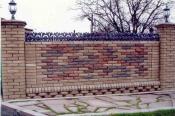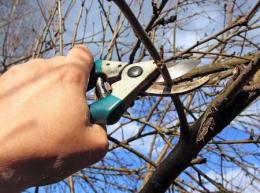Search
Login
Pruning a garden in spring, pruning fruit trees
With all the love for the flora and the recognition of the beauty of its natural primeval nature, shrubs and trees, especially fruit trees, require care. The main function of fruit trees, fruiting, can be performed only with professional care and timely help of gardeners, i.e. watering, top dressing and of course - pruning. Spring pruning is very significant and important for fruit trees. This procedure allows you to form the correct shape of the crown. This, in turn, will provide unhindered access to each of the branches of oxygen and sunlight, thereby significantly reducing the predisposition to various diseases and significantly increase the quality of fruiting.
Content:
- Fruit trees in spring
- Pruning fruit trees video
- Fruit tree formation
- Features winter pruning
- Features of spring pruning
- How to prune apple and pear trees in spring video video
- Pruning trees in autumn
Fruit trees in spring
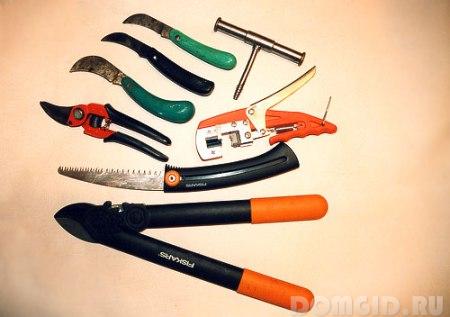
In order to properly and accurately maintain the plants in order, you will need the following tools for pruning trees:
- secateurs - should be with such a mechanism that will allow the branch to be eliminated at a time, should comfortably fit into the hand and be practical to use;
- garden hacksaw - must be with a narrowed end of the blade, the teeth must be equipped with so-called spaces that prevent the accumulation of sawdust, in no case should you replace the hacksaw with a construction one; the entire tool for trimming fruit and berry shrubs and trees should be specially profiled and designed for these works;
- air pruner - it has the form of an elongated telescopic rod, the pruner is attached to one of its ends, it is operated with levers and a rope, the importance of such a tool comes when it comes to pruning branches, access to which is impossible or difficult.
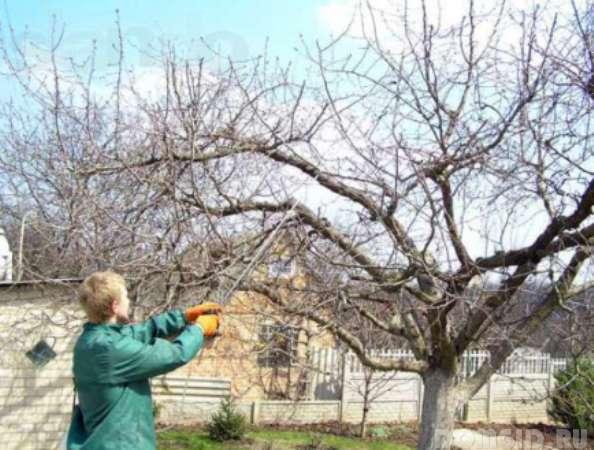
It is very important to monitor the sharpness of the tools used when cutting trees. In a torn incision received from a blunt or not sharp enough tool, it is very likely to expect the development of a colony of microorganisms that seriously harm both a single branch and the whole tree or shrub as a whole. After finishing work with gardening tools for pruning, they should be cleaned and thoroughly wiped with a cloth dampened with oil.
In addition to the tools you will need a garden var. Var in consistency resembles ointment. It is prepared from refined products. Wounds treat wounds on the surface of shrubs and trees. But you need to remember that var can be used for putty only at positive street temperature. To replace it, you can use oil paint, because it is based on drying oil.
Garden tools of high quality and maximum sharpness will provide a virtually painless cutting procedure.
Pruning fruit trees
Pruning can be produced in many ways. Which one to use depends on what kind of result you need to achieve.
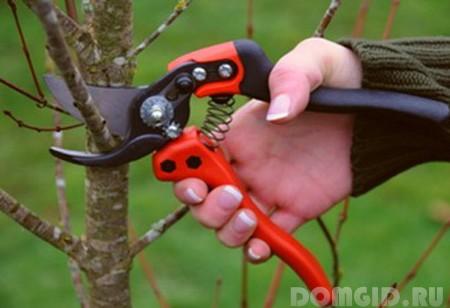
The first method is a kidney cut. This method is mainly used to give a branch of growth in a certain direction. Apply this method on branches that have reached a year old. Choose a kidney whose growth is directed in the right direction. In order to correctly perform circumcision, you need to determine an angle of 45 degrees in the direction of the branch.
Circumcision should be carried out as accurately as possible and to avoid errors in the form of: large left hemp, kidney injury, incorrect determination of the angle of incision. The secateurs must be held so that the plate that performs the cut is turned towards the part that remains on the tree.
At the time of circumcision, you should be as focused as possible and not allow too sharp a cut. In cases of performing work in this form, the kidney is likely to die, because it will not be able to receive enough nutrition to wake up.
The second way is to cut into the ring.This type of pruning involves removing an entire branch. The branch that has the wrong direction of growth (for example, deep into the crown) should be removed. if such a branch is ignored, it will receive sufficient nutrition for active growth, but it will not bear fruit at all. A slice of this kind is produced by secateurs only in cases where this allows the thickness of the branch.
The third way is to cut to the side branch. This type is used in cases where there is a need to transfer the course of active growth from one branch to another. Unnecessary, in such cases, is removed. A slice must be made so that it creates a continuation view with respect to the branch that remains. Thus, the lateral branch becomes the main one.
How to prune fruit trees in the spring we look at the video:
Fruit tree formation
Since every gardener producing tree pruning pursues different ultimate goals, there are different types of pruning.
Formative. It makes it possible to make the crown of the desired density and achieve the desired tree silhouette. Only a properly formed skeleton of a tree gains stability under certain loads.
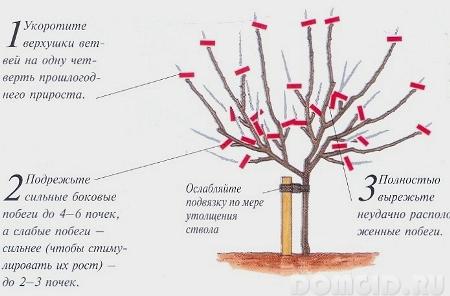
Forming circumcision performed in the month of February promotes more intensive growth of branches, and circumcision made in mid-March-early April - on the contrary, inhibits active growth.
Regulatory. Performs the function of control over an already formed crown. In addition to this, it allows sunlight to freely penetrate the branches, as well as unnecessarily not load the skeleton of the tree with newly formed shoots. The timing of the trim is appropriate from February to April and from August to September.
Anti-aging. It allows old plants to get a charge at the beginning of the renewal process and thereby stimulates the growth of young branches.

In cases where the plant gives each year an increase in branches from 10 to 15 cm, there is a need to shorten them. Such actions will serve as a stimulation to the active awakening of sleeping and adnexal kidneys. Experts advise such rejuvenation in late winter, early autumn and spring.
Recovery.This type of circumcision makes it possible for trees that have received any damage to return to normal and active growth, flowering and fruiting.
Sanitary. This pruning is reduced to the removal of dried, damaged, broken or diseased branches from plants. Sanitary pruning can be done all year round, but not on days when the street temperature is below zero. Having performed a cut of diseased or diseased shoots, it is recommended to disinfect the instruments with technical alcohol. Performing such pruning, you need to take into account the age and dimensions of the tree. Too intense actions can lead to thickening of the crown.
Features winter pruning
There is one important rule here - do not prune trees and shrubs when the street temperature is below zero. It is on such days that the tree becomes especially fragile. Branches in this state are easily deformed and damaged, and the healing process is slow and poor. On days when the air temperature drops below 6-7 degrees, pruning should be postponed.

There are positive aspects in winter pruning - since there is no leaf cover, the crown becomes well visible from all sides, and therefore all defects are also clearly visible. Also, the advantages of winter pruning can be attributed to: the trees feel the pruning minimally, it is possible to perform more accurate and high-quality cuts.
When cutting thick branches, you only need to use a saw. In order to avoid injury to the branches, it is necessary to file both on the one hand and on the opposite.
Features of spring pruning
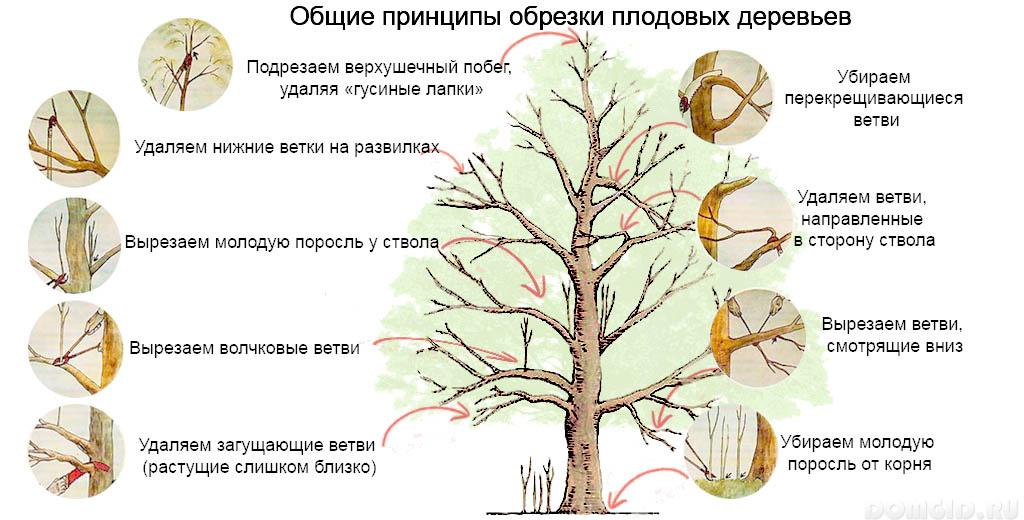
According to many amateur gardeners, spring pruning should be done before the plants begin the period of sap flow. However, experienced specialists are strongly advised to perform such circumcision at a time when the process of sap flow has not yet begun, but should begin soon. It is worth listening to their opinion and clearly determining the agreed time. It is during this period that the plant must be in a state of awakening. The pruned plant, having woken up completely, will be able, with minimal losses of useful trace elements, to contribute to the active healing of the resulting wounds.
The time period for pruning trees of different varieties is different from each other. This feature makes it possible to plan the procedure and have time to do everything before the start of the sap flow process.
After pruning, the wound on the tree should be treated with garden varieties, oil-based paint or cow dung mixed with yellow clay. To carry out spring pruning, you should choose a warm day, a day when the air temperature will not be lower than -3 -4 C degrees.
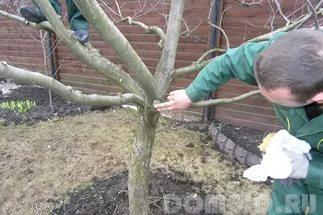
Spring pruning of shrubs that have to survive flowering is strongly not recommended. This feature applies to plants whose flower budding occurs only on year-old branches. Otherwise, the owner will deprive himself of emotion from observing the delightful flowering.
How to prune apple and pear trees in spring
Pruning apple trees in the spring has some features that must be taken into account when performing work in the garden, first of all, you should take into account the active sap flow, which begins with the onset of spring, so pruning should be done with extreme caution. A careless attitude to the procedure may cause serious damage to the tree. The main purpose of spring pruning can be considered the removal of excess branches and processes in order to properly form the crown.
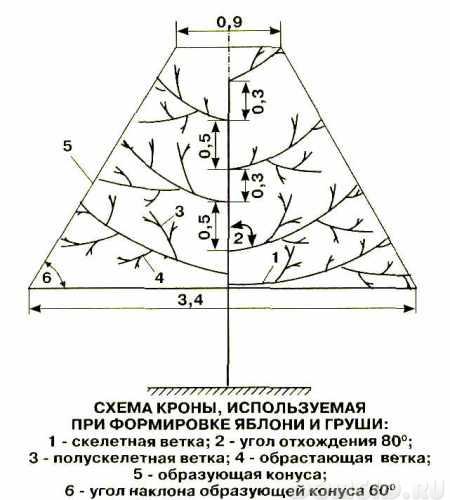
First of all, damaged branches and those whose buds are not sufficiently swollen, i.e. for some reason they do not develop.
The earlier spring pruning is carried out, the more time is left at the tree to prepare for flowering and fruiting.
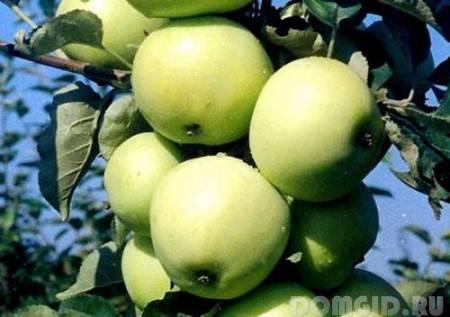
You can see in more detail how apple pruning is performed in spring on the video:
Experienced gardeners believe that pruning a pear in the spring is an ideal option for forming the correct crown of a tree. Spring pruning is done before the sap flow begins and the leaves bloom.
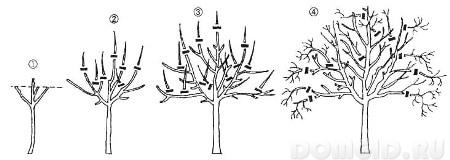
Depending on the age of the tree, different pruning options are used. For example, two-year-old seedlings of pears are cut to a height of 0.5 m, this will contribute to the active formation of shoots from the lower buds.
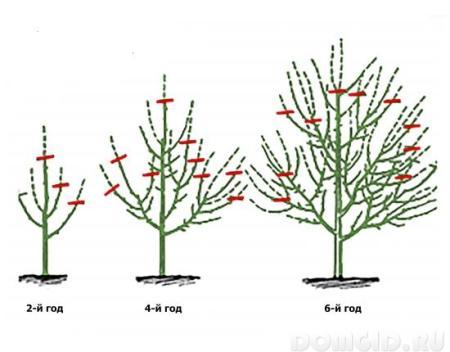
In subsequent years, the central trunk is shortened by a quarter, leaving only 4 of the side branches, the rest are to be removed.
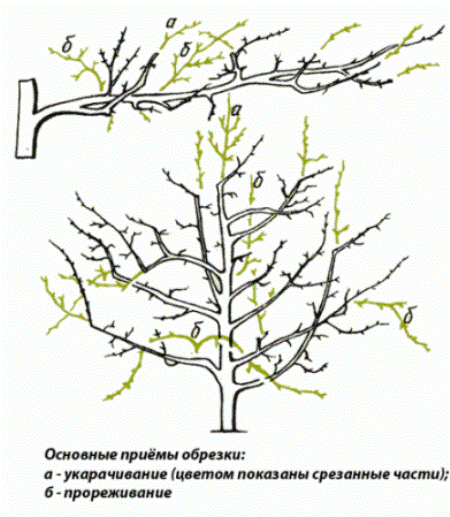
In the same way, they continue to form a tree over the next years, while not allowing the second-order branches to exceed the growth of the main ones. Branches thickening the crown, i.e. growing inside her.
To increase the growth activity of the shoots, the branches inside the tree crown and along its periphery are shortened. Naturally, weaker and damaged branches are removed.
In spring, pear pruning is performed after the positive temperature is established - in severe frosts, the tree can be seriously damaged after pruning.
We look at the video how to correctly trim the pear in the spring:
Pruning trees in autumn
Most fruit-bearing trees do not survive autumn pruning. For example, plums, cherries or pears can not only seriously hurt after such pruning, but even die. If there is no special need for this procedure, it makes sense to transfer it to the spring. Also, you should not expose plants that have not completely taken root to such a procedure, that is, young and not strong. This, almost completely, will lead to their death.
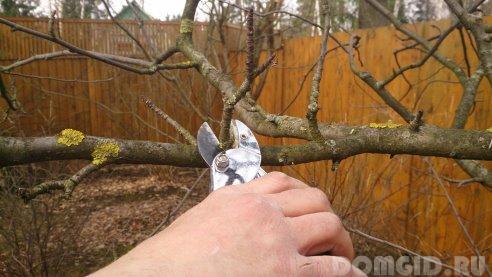
Basically, autumn pruning comes down to sanitary. It is worthwhile to understand that a long and cold winter awaits the plant ahead, which it will be much easier for it to survive without extra wounds. A tree covered with sores has little chance of surviving the winter well.
Autumn pruning should be carried out at a temperature not lower than -4 -5 C degrees. Although, if the pruning is sanitary, then the affected or diseased branches should be cut off without delay, and thereby preventing spread to healthy areas. Removed affected branches or parts of a tree should be burned immediately.

